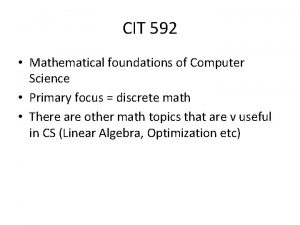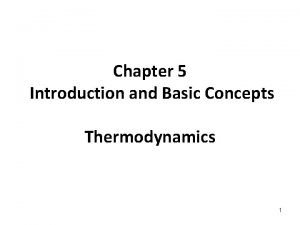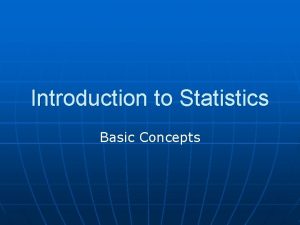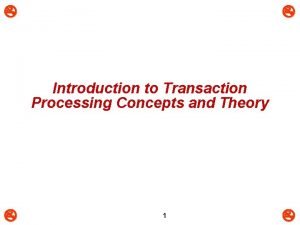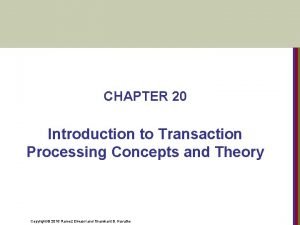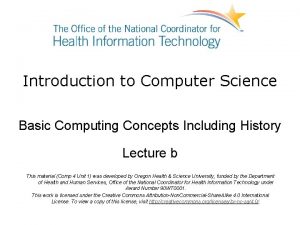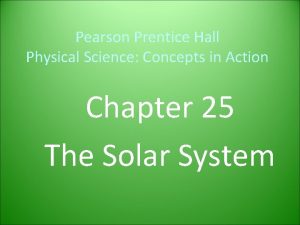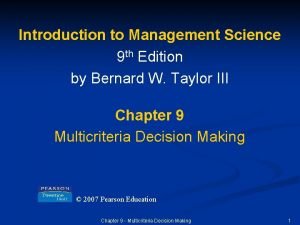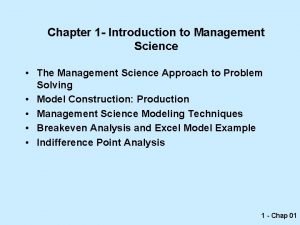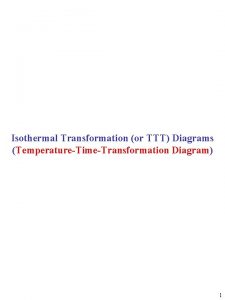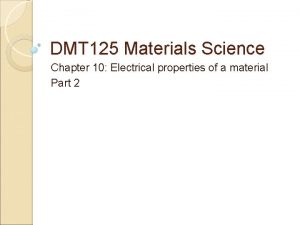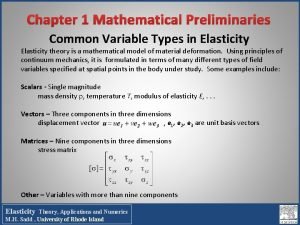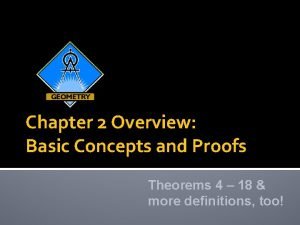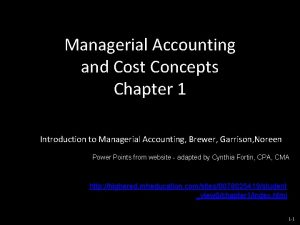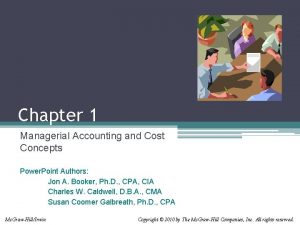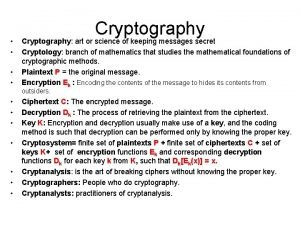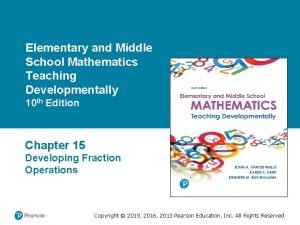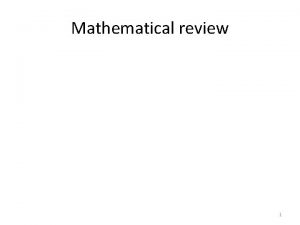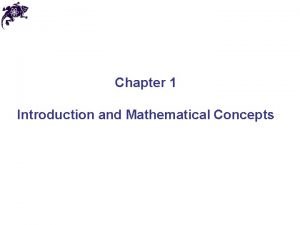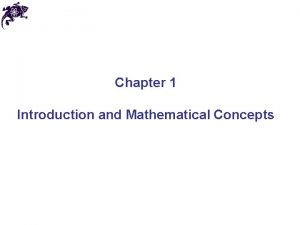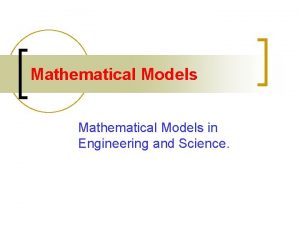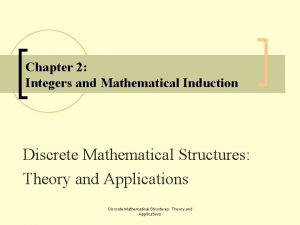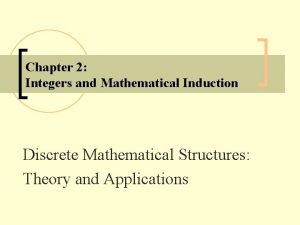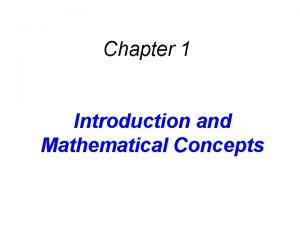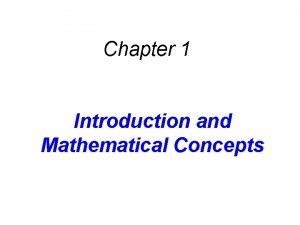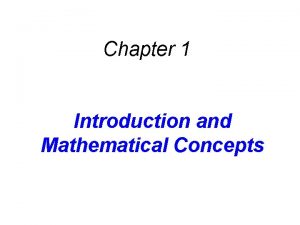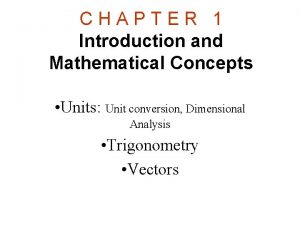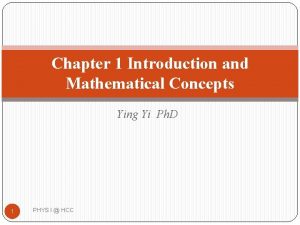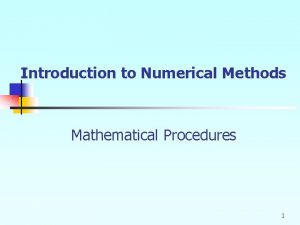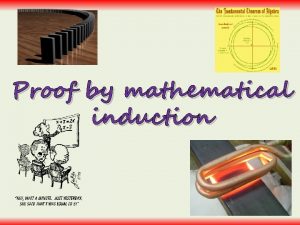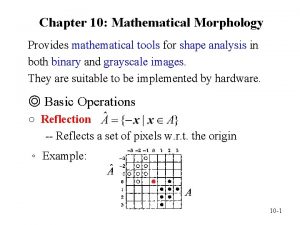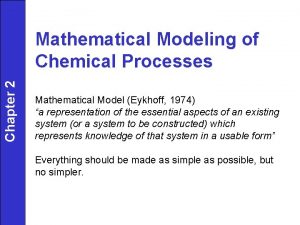Chapter 1 Introduction and Mathematical Concepts Science what








































- Slides: 40

Chapter 1 Introduction and Mathematical Concepts

Science: what is it? • Science is a system of acquiring knowledge (research) based on 1) empiricism (dependence on observable evidence) 2) experimentation 3) methodological naturalism (ruling out recourse to the supernatural) 4) organized body of knowledge gained by such research • Scientific investigation must adhere to the scientific method, a process for evaluating empirical knowledge that explains observable events as a result of natural causes

Scientific method: what is it? • Description: information must be reliable, replicable and relevant to the inquiry • Prediction: information must be valid for past, present, and future observations of given phenomena • Control: active and fair sampling of possible occurrences, whenever possible and proper (as opposed to the passive acceptance of opportunistic data) • Falsifiability: elimination of plausible alternatives – a gradual process requiring repeated experiments by multiple researchers who must be able to replicate results in order to corroborate them

Falsifiability • This requirement is one of the most frequently contended • All hypotheses and theories are in principle subject to disproof – peer review is a must • There is a point at which there might be a consensus about a particular hypothesis or theory, yet it must in principle remain tentative • As a body of knowledge grows and a particular hypothesis or theory repeatedly brings predictable results, confidence in the hypothesis or theory increases

Problem-solving skills

Problem-solving skills • Equations are the tools of physics – understand what they mean and how to use them • Carry through the algebra as far as possible – substitute numbers at the end

Measurement • We measure things (such as weight, time, length, speed, etc. ) • We use tools (rulers, clocks, speedometers, etc. ) to measure things • Measurement tools are calibrated • Calibration is in units (inches, seconds, pounds, mph’s, etc. ) • Units require standards (conventional, habitual, customary)

Modern standards • Not all quantities in nature are independent (e. g. , speed is distance per time) • Standards are created for independent (base) quantities: length, time, mass, + some other • Modern day standards should be as invariable as possible • Should be uniformly defined • Should be accessible

SI (Systéme Internacional) – most accepted international system of units • Adopted in 1971 • Is commonly known as metric system • Standard units are (there are more): 1 m (meter) for length 1 s (second) for time 1 kg (kilogram) for mass • All other SI units are defined as derivatives of the base units (e. g. , energy: 1 J (Joule) = 1 kg x 1 m 2 / s 2)

Length • SI unit – m (meter) • Initially adopted as one ten-millionth of a distance between the North pole and the equator (standard – platinum-iridium bar) • Currently - a modern standard: 1 m = the length of the path traveled by light in vacuum during a time interval of 1/299 792 458 of a second

Time • SI unit – s (second) • Historically 1 s = 1 / 8640 day • Currently - a modern standard: 1 s = the duration of 9, 192, 631, 770 periods of the radiation corresponding to the transition between the two hyperfine levels of the ground state of the Cs 133 atom

Time • SI unit – s (second) • Historically 1 s = 1 / 8640 day • Currently - a modern standard: 1 s = the duration of 9, 192, 631, 770 periods of the radiation corresponding to the transition between the two hyperfine levels of the ground state of the Cs 133 atom

Mass • SI unit – kg (kilogram) • Historically 1 kg – mass of 1 liter of water • Initially adopted in prototype of the kilogram was made of platinum-iridium and declared: “This prototype shall henceforth be considered to be the unit of mass” • Currently - an alternative modern standard: 1 kg = mass of C 12 atom * 1026 / 1. 99264824 (Don’t confuse mass and weight: 1 kg is the same on the Earth and on the Moon)

Scientific notation 237 000 s = = 2. 37 x 108 s = = 2. 37 E 8 s 0. 0000664 m = = 6. 64 x 10 -5 m = = 6. 64 E-5 m

SI system prefixes Factor Name Symbol 1024 yotta Y 10 -1 deci d 1021 zetta Z 10 -2 centi c 1018 exa E 10 -3 milli m 1015 peta P 10 -6 micro µ 1012 tera T 10 -9 nano n 109 giga G 10 -12 pico p 106 mega M 10 -15 femto f 103 kilo k 10 -18 atto a 102 hecto h 10 -21 zepto z 101 deka da 10 -24 yocto y Examples: 1. 25 E 4 J = 12. 5 k. J 2. 34 x 10 -10 s = 0. 234 ns

Good SI web resource: National Institute of Standards and Technology (NIST) http: //physics. nist. gov/cuu/Units/

Dimensional analysis • Technique to check the correctness of an equation • Dimensions (length, mass, time, combinations) can be treated as algebraic quantities • Both sides of equation must have the same dimensions • Limitation: cannot give numerical factors

Chapter 1 Problem 6 Consider the equation: The dimensions of the variables v, x, and t are [L]/[T], [L], and [T], respectively. The numerical factor 3 is dimensionless. What must be the dimensions of the variable z, such that both sides of the equation have the same dimensions?

Conversion of units • Need to know a conversion factor • Use chain-link conversion (Check inside front cover for SI conversion factors)

Order of magnitude • Order of magnitude is the power of 10 that applies • Divide the number by the power of 10 • Compare the remaining value to 3. 162 ( ) • If the remainder is less than 3. 162, the order of magnitude is the power of 10 in the scientific notation • If the remainder is greater than 3. 162, the order of magnitude is one more than the power of 10 in the scientific notation

Uncertainty in measurements • There is uncertainty in every measurement, it is carried over through the calculations • Rules for significant figures are used to approximate the uncertainty in results • A significant figure is one that is reliably known • All non-zero digits are significant • Zeros are significant when: a) between other nonzero digits; b) to the right of non-zero significant digits; c) can be clarified by using scientific notation

Uncertainty in measurements • Accuracy is a number of significant figures • When multiplying or dividing two or more quantities, the number of significant figures in the final result is the same as the number of significant figures in the least accurate of the factors being combined • When adding or subtracting, round the result to the smallest number of decimal places of any term in the sum • If the last digit to be dropped is less than 5, drop the digit, otherwise raise the last retained digit by 1

Coordinate systems • Coordinate systems are used to describe the position of a point in space • Coordinate system consists of: 1) a fixed reference point called the origin 2) specific axes with scales and labels 3) instructions on how to label a point relative to the origin and the axes • Types of coordinate systems: Cartesian, plane polar, etc.

Coordinate systems • Cartesian (rectangular) coordinate system: x- and y- axes; points are labeled (x, y) • Plane polar coordinate system: origin and reference line are noted; point is distance r from the origin in the direction of angle θ; ccw from reference line; points are labeled (r, θ)

Brief trigonometry review • Pythagorean theorem: • To find an angle, you need the inverse function • Be sure your calculator is set appropriately for degrees or radians

Types of physical quantities • In physics, quantities can be divided into such general categories as scalars, vectors, matrices, etc. • Scalars – physical quantities that can be described by their value only • Vectors – physical quantities that can be described by their value (magnitude) and direction

Vectors • Vectors – physical quantities having both magnitude and direction • Vectors are labeled either a or • Vector magnitude is labeled either |a| or a • Two (or more) vectors having the same magnitude and direction are identical

Vector sum (resultant vector) • Not the same as algebraic sum • Triangle method of finding the resultant: a) Draw the vectors “head-to-tail” b) The resultant is drawn from the tail of A to the head of B R=A+B B A

Addition of more than two vectors • When you have many vectors, just keep repeating the process until all are included • The resultant is still drawn from the tail of the first vector to the head of the last vector

Commutative law of vector addition A + B = B + A

Associative law of vector addition (A + B) + C = A + (B + C)

Negative vectors Vector (- b) has the same magnitude as b but opposite direction

Vector subtraction Special case of vector addition: A - B = A + (- B)

Multiplying a vector by a scalar • The result of the multiplication is a vector c A = B • Vector magnitude of the product is multiplied by the scalar |c| |A| = |B| • If the scalar is positive (negative), the direction of the result is the same as (opposite to that) of the original vector

Vector components • Component of a vector is the projection of the vector on an axis • To find the projection – drop perpendicular lines to the axis from both ends of the vector – resolving the vector

Vector components

Unit vectors • Unit vector: A) Has a magnitude of 1 (unity) B) Lacks both dimension and unit C) Specifies a direction • Unit vectors in a right-handed coordinate system

Adding vectors by components In 2 D case:

Chapter 3 Problem 52 Two geological field teams are working in a remote area. A global positioning system (GPS) tracker at their base camp shows the location of the first team as 38 km away, 19° north of west, and the second team as 29 km away, 35° east of north. When the first team uses its GPS to check the position of the second team, what does the GPS give for the second team’s (a) distance from them and (b) direction, measured from due east?

Questions?
 Introduction and mathematical concepts
Introduction and mathematical concepts Introduction and mathematical concepts
Introduction and mathematical concepts Econ213
Econ213 Think central science fusion
Think central science fusion One of my favorite subjects
One of my favorite subjects Cit 592 mathematical foundations of computer science
Cit 592 mathematical foundations of computer science Chapter 1 intro to forensic science
Chapter 1 intro to forensic science Introduction and basic concepts of thermodynamics
Introduction and basic concepts of thermodynamics Thermodynamics introduction and basic concepts
Thermodynamics introduction and basic concepts Introduction to statistics and some basic concepts
Introduction to statistics and some basic concepts Introduction to transaction processing concepts and theory
Introduction to transaction processing concepts and theory Transaction processing in dbms
Transaction processing in dbms Pearson physical science concepts in action answers
Pearson physical science concepts in action answers Basic concepts of computer science
Basic concepts of computer science Pearson physical science concepts in action
Pearson physical science concepts in action Computer science basic concepts
Computer science basic concepts Chemical property definition
Chemical property definition Pearson physical science concepts in action
Pearson physical science concepts in action Pearson physical science concepts in action
Pearson physical science concepts in action Introduction to management science solution
Introduction to management science solution Introduction to management science chapter 1 solutions
Introduction to management science chapter 1 solutions Introduction to materials science for engineers chapter 10
Introduction to materials science for engineers chapter 10 Chapter 1 introduction to science
Chapter 1 introduction to science Chapter 1 introduction to earth science
Chapter 1 introduction to earth science Introduction to materials science for engineers chapter 10
Introduction to materials science for engineers chapter 10 Introduction to marketing concepts
Introduction to marketing concepts Introduction to programming concepts with scratch
Introduction to programming concepts with scratch Chapter 1 mathematical preliminaries
Chapter 1 mathematical preliminaries Promotional concepts and strategies
Promotional concepts and strategies Contrast trade promotions and consumer sales promotions.
Contrast trade promotions and consumer sales promotions. Chapter 2 analyzing transactions answer key
Chapter 2 analyzing transactions answer key Reviewing concepts and vocabulary chapter 1
Reviewing concepts and vocabulary chapter 1 Chapter 2 basic concepts and proofs answers
Chapter 2 basic concepts and proofs answers Chapter 1 managerial accounting and cost concepts
Chapter 1 managerial accounting and cost concepts Chapter 1 managerial accounting and cost concepts
Chapter 1 managerial accounting and cost concepts Natural science and social science similarities
Natural science and social science similarities Hard and soft science
Hard and soft science Cryptology an introduction to the art and science
Cryptology an introduction to the art and science The central science 14th edition
The central science 14th edition Chapter 33 entrepreneurial concepts answers
Chapter 33 entrepreneurial concepts answers Chapter 15 developing fraction concepts
Chapter 15 developing fraction concepts





